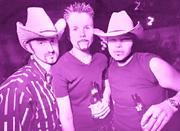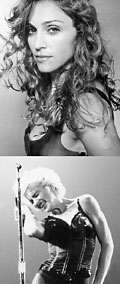THRONGS OF WOMEN—from the surliest butch dyke to the cutest androgyne to the most fashionable lipstick lesbienne—filled folding chairs and lined the beer-splashed walls for a Drag King show at Re-bar recently. On stage, a slim, handsome C鳡r began his trek home from the market, then stumbled upon a blonde bombshell whose clothes could hardly contain her curves. C鳡r’s eyes narrowed and a lascivious grin widened just beneath his neatly trimmed mustache. As the two strangers’ hips locked together in a salsa sway, audience members’ reactions varied: Some reached for a cigarette, others rooted the Latin lover on; some laughed hilariously, others frowned dubiously. Whatever the response, there was no doubt about the excitement that crackled through the room.
Historically, this crackle has been muted by the deafening disco tunes adopted by drag queens, but a few male impersonators managed to gain notoriety during the early part of the 20th century. Writer Judith “Jack” Halberstam and photographer Del Lagrace Volcano’s The Drag King Book, a comprehensive, gorgeously photographed look at Drag Kings, recalls Gladys Bentley, a blues singer of the Harlem Renaissance who “regularly donned a butch tuxedo and sang songs about ‘bulldaggers,'” as one of the earliest Drag Kings. Thanks to drag queens’ help, such spaces as New York’s now-defunct Club Casanova, and pioneers like the un-p.c. “I ain’t no homo” Mo B. Dick, the middle-aged Murray Hill, and the rap star Shon, Drag King scenes have come to grow if not flourish in London, San Francisco, New York, and even Columbus, Ohio.
Seattle’s not far behind. Michal Blum and Sara Johnston have been organizing Drag King shows over the past year as fundraisers for PUSH, Dyke Action’s ‘zine. In addition to a scoring C鳡r, some of the final show’s more memorable performances included a troupe of lip-synching ‘N Sync-ers doing “Bye Bye Bye”; the talented Jenny West using Supertramp’s “Logical Song” to strip from coat and tie to a tee reading GIRLS RULE; the uniformed Bamboo Clan abusing a blow-up doll in a commentary on American military men’s exploitation of Asian women; and the sexiest of all, Chance, a Prince imitator in see-through pants cooing and crawling her way into the open arms of audience members.
Is That a Banana in Your Pocket?
In The Drag King Book, Volcano writes, “When asked, ‘What’s a Drag King?’ I reply: ‘Anyone (regardless of gender) who consciously makes a performance of masculinity.'” Halberstam goes on to break Drag Kings down into two types: The first is the “butch Drag King,” who showcases “what comes naturally, and s/he celebrates her masculinity or distinguishes between her masculinity and male masculinity.” The second is the “femme Drag King” or “androgynous Drag King,” who “understands herself to be engaged in some kind of parody of men and s/he leaves her masculinity behind when s/he takes off the fake hair and the boxers and the chest binding.”
The styles of performances and the performers’ personal identities, however, are limitless. Blum remarks that this holds true for Seattle Drag Kings, as acts can range from sensual pelvic thrusting to macho posturing, from bathroom humor to political ranting. The identities are just as varied: Performers come in femme to butch versions of bi, lesbian, transgendered, and straight women. Even men can get in on the act, as Re-bar owner Steve Wells, a.k.a. Everett Mall Jr. (Blum calls him “our honorary dyke”), demonstrated when he opened last month’s show with a heavy-on-the-cheese rendition of Gene Pitney’s “Town Without Pity.”
What’s the big deal about a bunch of women acting like guys on stage? The brouhaha—and the difference between drag on MTV and a Drag King performance— is that there’s more to being a Drag King than sporting a pompadour or leering at the big-breasted babe in the front row. Madonna and Hilary Swank, for example, aren’t any threat to the straight white males at the top of the power pyramid in American society so long as the trousers eventually come off to reveal a feminine, heterosexual woman.
Drag Kings can’t make such promises: Even if a Drag King agrees to shave the goatee or unstrap the strap-on, the threat remains that s/he very well might refuse to be penetrated, in turn making those at the top of the pyramid—god forbid—penetrable.
The Royal Family
Just as clowns can frighten young children, so Drag Kings’ masculinities can disturb some members of the queer community. Nationally, women-to-men transsexuals have complained that Drag Kings’ performances trivialize the daily struggle they endure on the rough road to manhood. Locally, some lesbians have frowned upon the misogyny and homophobia in Seattle Drag Kings’ performances. A performer in addition to a show organizer, Johnston believes the scene should be a “celebration of gender and difference,” not a mere imitation of sexist views and values. Local Drag King Dick (of the Dick & Tyler duo, based on the show in Tim Allen’s sitcom Home Improvement), however, claims that the offended need to “lighten up a little bit” and remember that even before politics, Drag King performances are “just entertainment.” Similarly, Blum warns that Drag Kings are an act and somewhat of a joke, and audiences should “expect to be offended.”
Conversely, seriousness hasn’t come so easily to Seattle Drag Kings. Blum admits that the local scene is still quite amateurish and asserts, “Anyone who wants to do it should try it.” She maintains that the scene is “not a clique,” and she’d love to see Drag King workshops teach community members the art of applying facial hair and strutting like a stud. Likewise, Johnston would prefer the scene nurse inclusiveness rather than ego.
Dick & Tyler, on the other hand, wish performers would spend more time honing their skills. Though local Drag Kings may have the sexuality and choreography down pat, their personalities and attitudes can’t match those found in more metropolitan scenes. Dick mentions that Seattle’s drag queens “really put a lot of themselves into it,” while the city’s Drag Kings lack in swaggering cockiness. Like Blum and Johnston, Dick & Tyler don’t want to bar newcomers from the scene, but they do hope it transforms into something that’s “less about just being on stage and more about performing and cultivating a professional Drag King identity.”
While drag queens can kick up their high heels in spaces like Foxes, Neighbours, and ARO.space, Drag Kings, for the most part, have been restricted to—yet nourished by—Re-bar. With a little more maturation and presence, however, Seattle Drag Kings shouldn’t have a problem filling out their britches as well as other venues. As Blum says, “The more visibility we have, the bigger it will get.”
The next Drag King show will be held as part of Home Alive’s Awareness Week at ARO.space on Wed 7/12; call 720-0606 for more information.








